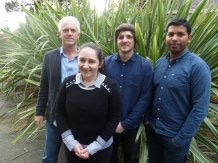Apr 3 2017
 Members of the research team who developed the innovative technique. (Credit: University of Exeter)
Members of the research team who developed the innovative technique. (Credit: University of Exeter)
Engineering experts from the University of Exeter have come up with a breakthrough way to create the smallest, quickest, highest-capacity memories for transparent and flexible applications that could lead to a future golden age of electronics.
The Exeter researchers developed new memories using a hybrid of titanium oxide and graphene oxide. Their devices are not only economical and eco-friendly to produce, but also ideally suited for use in flexible electronic devices such as computer and TV screens, ‘bendable’ mobile phone, and even ‘intelligent’ clothing.
Significantly, these devices may also have the potential to provide a cheaper and more adaptable substitute to ‘flash memory’, which is at present used in a number of common devices such as memory cards, USB computer drives and graphics cards.
The research team claims that these ground-breaking new devices have the potential to transform not only how data is stored, but also move flexible electronics to a new age in terms of efficiency, speed and power.
The research has been published in the leading scientific journal ACS Nano.
Using graphene oxide to produce memory devices has been reported before, but they were typically very large, slow, and aimed at the ‘cheap and cheerful’ end of the electronics goods market. Our hybrid graphene oxide-titanium oxide memory is, in contrast, just 50 nanometres long and 8 nanometres thick and can be written to and read from in less than five nanoseconds – with one nanometre being one billionth of a metre and one nanosecond a billionth of a second.
Professor David Wright, Electronic Engineering Expert, University of Exeter
Professor Craciun, a co-author of the work, added: “Being able to improve data storage is the backbone of tomorrow’s knowledge economy, as well as industry on a global scale. Our work offers the opportunity to completely transform graphene-oxide memory technology, and the potential and possibilities it offers.”
The research was performed along with IBM Zurich under the support of the EU FP7 project CareRAMM (grant number 309980).